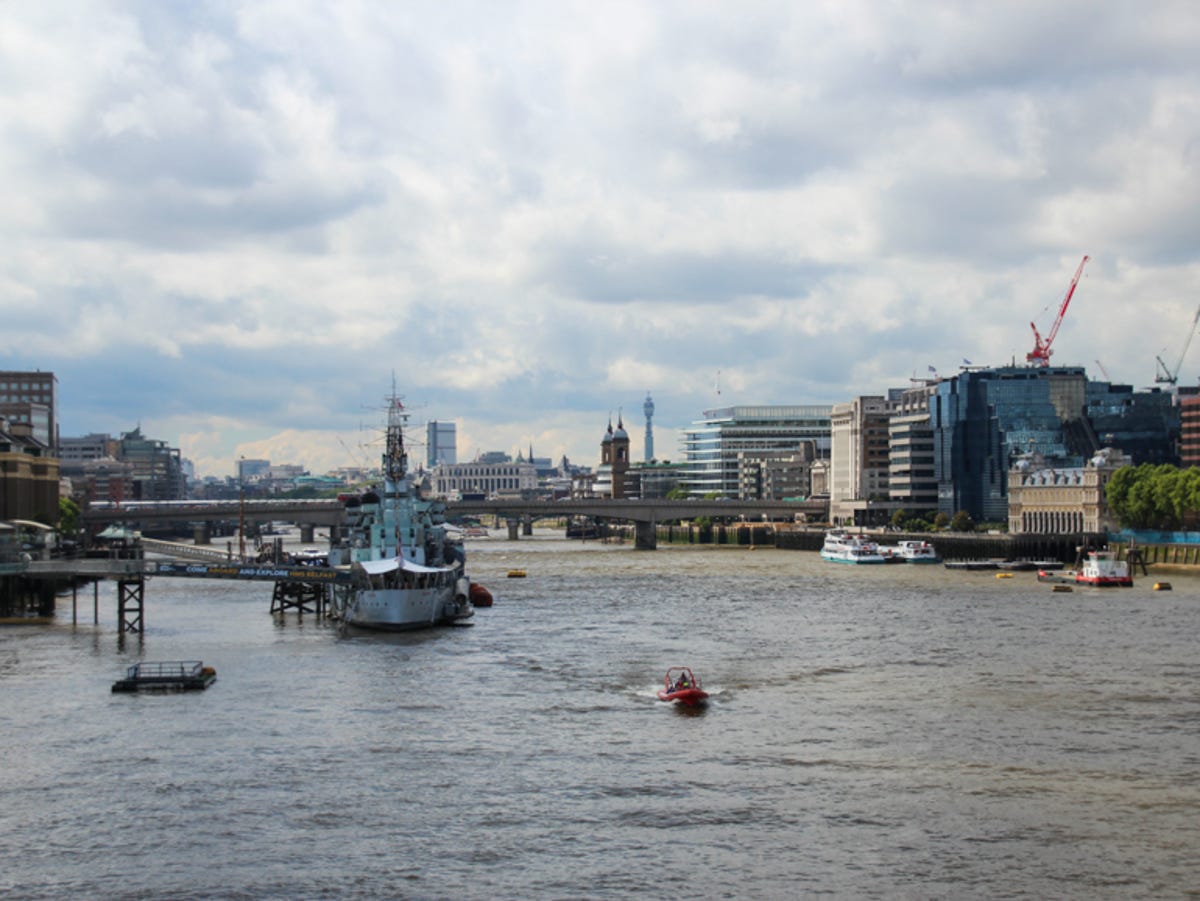
In the Pool of London
The HMS Belfast served her country for 24 years, including firing on the beaches before the D-Day invasion, helping sink the German battleship Tirpitz, and more. It's now a museum ship. For the full story, check out: Take a tour of the HMS Belfast.
Town-class
The walk across the gangplank from the South Bank of the river Thames gives you a good sense of the size. It’s a light cruiser, so it’s a lot smaller than other WWII vessels you can tour.
Ship's bell
One of the first things you see when you board the Belfast is the solid silver ship's bell.
Looking aft
Down the length of the ship, Tower Bridge downriver.
Once enemies, now friends
The ship docked alongside the Belfast on one of my tour days was the German cruise ship Berlin. If that’s not a sign of time and the world moving on, I don’t know what is.
Load them guns
Inside the front turret. The shells are lifted from far below (which we’ll see later).
Anchor's aweigh
A serious anchor.
Starboard amidships
Like most museum ships, many passageways are filled with other exhibits. Here, a replica of one of the torpedoes the Belfast carried.
Clean clothes
The laundry room from the 1950s refit. Before then the crew washed their laundry in buckets.
Meow
Yep, that’s a cat. These soulless killing machines were kept on board to do what they did best: kill things. Specifically, mice.
Art
There was an art exhibit called "The Tourists" going on when I was there. It was some kind of take on Mardi Gras. It was freaky.
From this room music was piped through the ship.
Woodworking
Ships need to be able to repair themselves, to an extent, while on tour. Here you can see the shipwright’s room.
Sick bay
Recovery cots dead ahead, operating room to the right.
Root canal
Can’t escape the need for a dentist at sea.
Switches
There is something so cool, and sort of menacing, about exposed and massive switches like these.
Galley
The quite sizeable galley. It continues back farther about three rooms this size.
Soup?
Soup, anyone? Soup, everyone.
Hot cross buns
Fancy a biscuit? Yep, it’s a bakery.
Transmitting station
The mechanical computers here calculated where to aim the guns.
Forward steering position
Different from what you'd expect, the main steering wheel is actually inside the ship. No windows.
Gyro compass
This gyro compass always points north, to aid navigation in high seas.
Hot water
This washroom is close to the engine room, so hot water didn't have to get piped around the ship (much).
Pipes, tubes and ducts
The forward engine room. On the right is one of the huge fans to feed the boilers.
Engine room floor
A rare open space in the engine room. The boilers are on the right.
Maze
Imagine, there were many men who knew where every one of these pipes went and what it carried.
Not hot, right now
Pre-heated fuel oil got atomized here, to get sent through those tiny holes...
Furnace
...to the furnace to make steam. The steam was used for a variety of things, including turning generators for electric power.
Lucky 7
Up to seven of the "oil fuel registers" were used on each boiler.
Full speed ahead
Literally.
Throttles
Three separate controls: one for ahead, one for astern and one for efficient cruising.
Gears!
I saw this awesomeness on the far side of the engine room. Any guesses?
Reduction gear
This is one of the huge reduction gears connected to the propeller shaft.
Not exactly an LCD
These gorgeous analog dials gave the engineers everything they needed to keep the engines running.
Canteen
I thought they did a great job stocking the canteen with cans and goods that would have been found while the ship was in service.
Hammock Town
There were few crew quarters on the Belfast. Sailors instead had hammocks stretched above areas that had other uses.
Sleep where you eat
Not a lot of daily variety.
Armory
Deep inside the ship is the armory.
Up elevator
Ignore the creepy sailor mannequin. The shells would be loaded into elevators and raised into the turrets.
VHF and UHF equipment room
The gear here, along with antennas outside, allowed the Belfast to communicate with other vessels, the shore and so on.
Not bad for some
The officers got far better accommodations, with little things like "beds" and "a window."
Radar
Radar would have been cutting-edge naval technology in the Second World War, but of course the Belfast saw service afterwards and was kept up to date.
The bleeps, the sweeps and the creeps
I didn't detect any enemy aircraft. I might have been reading it wrong.
High tech
Here an incredibly lifelike mannequin worked to figure out what caused a blue screen of death. I guess Win98 was terrible in the '60s too.
Compass platform
The bridge (or compass platform, as it was called), was exposed prior to the 1950s refit.
The view upriver
Rumor has it the guns are fixed on a gas station on the M25, the motorway that rings London.
From the Tower
If you're headed to the Tower of London, or Tower Bridge, you can't miss the Belfast, and if you're a fan of WWII ships, you shouldn't.

